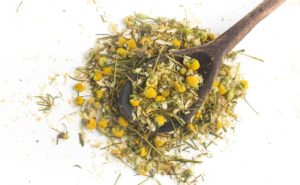La manzanilla, o camomila común o romana (A chamaemelum nobilel sin. Anthemis nobilis) es una planta herbácea que puede alcanzar los 60 cm de altura. Se distribuía originalmente en la zona de los Balcanes, el norte de África y Asia occidental, pero actualmente se cultiva en muchos países del mundo.
Se trata de una de las hierbas medicinales más antiguas de las que hay conocimiento, de hecho ya se consumía hace más de 3000 años en el Antiguo Egipto. En el Imperio Romano y en la Edad Media también se utilizaba como remedio medicinal.
Se cree que el interés por ella surgió debido a su intenso aroma. Eso llevó al descubrimiento de las diferentes propiedades que la hicieron tan famosa.

Conoce más de sus innumerables beneficios y propiedades terapéuticas para la salud:
- RELAJANTE. Al aumentar los niveles de serotonina y melatonina ayuda a reducir la ansiedad y el estrés.
- ANTIINFLAMATORIA. Ayuda para la pesadez de estómago por comidas en abundancia. A reducir gases y dolores menstruales
- SISTEMA INMUNITARIO. Sus compuestos fenólicos ayudan al sistema inmunitario a combatir infecciones bacterianas.
- CABELLO.Fortifica el bulbo piloso ayudando a fortalecer el cabello. También ayuda a eliminar la caspa y provoca que el pelo esté más brillante; es un remedio natural para aclararlo sin dañarlo.
- DIABETES Y ENFERMEDADES METABÓLICAS. Ayuda a controlar el índice glucémico.
- Estimula la descomposición de lípidos que contribuiye a reducir el índice de colesterol.
- EXFOLIANTE. Es un buen método exfoliante para la piel, además la deja suave y tersa. Reduce las manchas.
- CONJUNTIVITIS.Tiene efectos refrescantes sobre los ojos, por eso suele recomendarse su uso cuando uno tiene conjuntivitis.

Siempre es bueno estar informado al 100% y consultar con tu médico de confianza antes de tomar cualquier suplemento.
Producto 100% natural, su uso está destinado al consumo como alimento.
EL CONSUMO DE ESTE PRODUCTO ES RESPONSABILIDAD DE QUIEN LO RECOMIENDA Y DE QUIEN LO USA
REFERENCIAS
1) Safety Assessment of Anthemis nobilis-Derived Ingredients as Used in Cosmetics.
Johnson W Jr, Heldreth B, Bergfeld WF, Belsito DV, Hill RA, Klaassen CD, Liebler DC, Marks JG Jr, Shank RC, Slaga TJ, Snyder PW, Andersen FA.Int J Toxicol. 2017 May/Jun;36(1_suppl):57S-66S. doi: 10.1177/1091581817705620.PMID: 28553737
Anthemis nobilis (Roman chamomile) flower extract, anthemis nobilis flower oil, anthemis nobilis flower powder, and anthemis nobilis flower water are ingredients that function as fragrance ingredients and skin-conditioning a …
2) Chamomile.
[No authors listed]2017 Jan 23. LiverTox: Clinical and Research Information on Drug-Induced Liver Injury [Internet]. Bethesda (MD): National Institute of Diabetes and Digestive and Kidney Diseases; 2012–.PMID: 31643492 Free Books & Documents. Review.
Chamomile is an aromatic oil extracted from the flowers or leaves of the daisy-like plants including German chamomile (Matricaria recutita) and Roman or English chamomile (Chamaemelum nobile). Extracts, oils and teas made from chamomile are used for its soothing qualities …
3) Chamomile.
[No authors listed]2019 Jul 20. Drugs and Lactation Database (LactMed) [Internet]. Bethesda (MD): National Library of Medicine (US); 2006–.PMID: 30000867 Free Books & Documents. Review.
Two different plant species with similar effects are known as chamomile: German chamomile (Matricaria recutita) and Roman chamomile (Chamaemelum nobile). Both contain similar ingredients, including sesquiterpenes (e.g., bisabolol, farnesene), sesquiterpenelactones (e.g., c …
4) Antiprotozoal Activity-Based Profiling of a Dichloromethane Extract from Anthemis nobilis Flowers.
De Mieri M, Monteleone G, Ismajili I, Kaiser M, Hamburger M.J Nat Prod. 2017 Feb 24;80(2):459-470. doi: 10.1021/acs.jnatprod.6b00980. Epub 2017 Jan 24.PMID: 28116906
A dichlomethane extract of Anthemis nobilis flower cones showed promising in vitro antiprotozoal activity against Trypanosoma brucei rhodesiense and Leishmania donovani, with IC(50) values of 1.43 0.50 and 1.40 0.07 mug/mL, respectively. …
5) Essential oils and anxiolytic aromatherapy.
Setzer WN.Nat Prod Commun. 2009 Sep;4(9):1305-16.PMID: 19831048 Review.
Popular anxiolytic oils include lavender (Lavandula angustifolia), rose (Rosa damascena), orange (Citrus sinensis), bergamot (Citrus aurantium), lemon (Citrus limon), sandalwood (Santalum album), clary sage (Salvia sclarea), Roman chamomile (Anthemis nobilis), and r …
